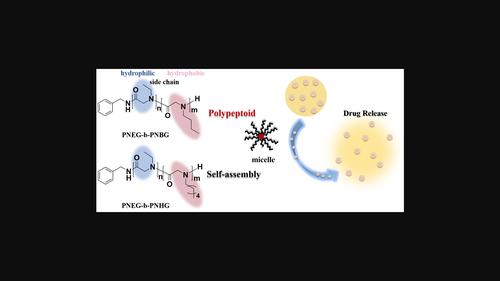求助PDF
{"title":"用于药物输送的两亲性多肽共聚物自组装胶束","authors":"Xiran Shen, Tiantian Wei, Di Liu, Kang Yang, Yangang Jiang, Jianwei Lu, Li Guo","doi":"10.1002/pi.6635","DOIUrl":null,"url":null,"abstract":"<p>Amphiphilic block copolymers are characterized by the presence of distinct hydrophilic and hydrophobic regions, which are usually arranged in alternating blocks. This unique structure allows these copolymers to self-assemble into well-defined nanostructures that exhibit remarkable resistance to enzymatic hydrolysis, high biocompatibility and the ability to be customized with specific structures. These properties make them highly desirable in various applications. Self-assembled amphiphilic polypeptoids are currently under development as a promising class of pharmaceutical agents. However, the utilization of these peptides as drug carriers for efficient delivery presents a number of challenges. These challenges include less-than-optimal loading efficacy and restricted biocompatibility. Herein, a series of stable amphiphilic block copolypeptoids (PNEG-b-PNBG and PNEG-b-PNHG) were designed and synthesized by controlled ring-opening polymerization. PNEG chain segments provide hydrophilicity, while PNBG and PNHG chain segments provide hydrophobicity. The hydrophobic molecular chains aggregate in aqueous solutions, resulting in the formation of nano-assemblies. The self-assembled amphiphilic block polypeptoid copolymers were investigated. The morphologies of copolymers take the form of micelles from tens of nanometers to a few hundred nanometers. The properties of amphiphilic block copolypeptoids used as drug carriers were further investigated by conducting drug release and cytotoxicity tests. The results indicate that the cumulative release efficiency of self-assembled polypeptoid copolymers can reach up to about 91%. And they have good biocompatibility and can be expected to be safe materials for efficient drug delivery. This work could provide a facile method for the preparation of amphiphilic block peptoid copolymers for biopharmaceutical applications. © 2024 Society of Industrial Chemistry.</p>","PeriodicalId":20404,"journal":{"name":"Polymer International","volume":"73 8","pages":"639-645"},"PeriodicalIF":2.9000,"publicationDate":"2024-03-30","publicationTypes":"Journal Article","fieldsOfStudy":null,"isOpenAccess":false,"openAccessPdf":"","citationCount":"0","resultStr":"{\"title\":\"Self-assembled polypeptoid micelles from amphiphilic polypeptoid copolymers for drug delivery\",\"authors\":\"Xiran Shen, Tiantian Wei, Di Liu, Kang Yang, Yangang Jiang, Jianwei Lu, Li Guo\",\"doi\":\"10.1002/pi.6635\",\"DOIUrl\":null,\"url\":null,\"abstract\":\"<p>Amphiphilic block copolymers are characterized by the presence of distinct hydrophilic and hydrophobic regions, which are usually arranged in alternating blocks. This unique structure allows these copolymers to self-assemble into well-defined nanostructures that exhibit remarkable resistance to enzymatic hydrolysis, high biocompatibility and the ability to be customized with specific structures. These properties make them highly desirable in various applications. Self-assembled amphiphilic polypeptoids are currently under development as a promising class of pharmaceutical agents. However, the utilization of these peptides as drug carriers for efficient delivery presents a number of challenges. These challenges include less-than-optimal loading efficacy and restricted biocompatibility. Herein, a series of stable amphiphilic block copolypeptoids (PNEG-b-PNBG and PNEG-b-PNHG) were designed and synthesized by controlled ring-opening polymerization. PNEG chain segments provide hydrophilicity, while PNBG and PNHG chain segments provide hydrophobicity. The hydrophobic molecular chains aggregate in aqueous solutions, resulting in the formation of nano-assemblies. The self-assembled amphiphilic block polypeptoid copolymers were investigated. The morphologies of copolymers take the form of micelles from tens of nanometers to a few hundred nanometers. The properties of amphiphilic block copolypeptoids used as drug carriers were further investigated by conducting drug release and cytotoxicity tests. The results indicate that the cumulative release efficiency of self-assembled polypeptoid copolymers can reach up to about 91%. And they have good biocompatibility and can be expected to be safe materials for efficient drug delivery. This work could provide a facile method for the preparation of amphiphilic block peptoid copolymers for biopharmaceutical applications. © 2024 Society of Industrial Chemistry.</p>\",\"PeriodicalId\":20404,\"journal\":{\"name\":\"Polymer International\",\"volume\":\"73 8\",\"pages\":\"639-645\"},\"PeriodicalIF\":2.9000,\"publicationDate\":\"2024-03-30\",\"publicationTypes\":\"Journal Article\",\"fieldsOfStudy\":null,\"isOpenAccess\":false,\"openAccessPdf\":\"\",\"citationCount\":\"0\",\"resultStr\":null,\"platform\":\"Semanticscholar\",\"paperid\":null,\"PeriodicalName\":\"Polymer International\",\"FirstCategoryId\":\"92\",\"ListUrlMain\":\"https://onlinelibrary.wiley.com/doi/10.1002/pi.6635\",\"RegionNum\":4,\"RegionCategory\":\"化学\",\"ArticlePicture\":[],\"TitleCN\":null,\"AbstractTextCN\":null,\"PMCID\":null,\"EPubDate\":\"\",\"PubModel\":\"\",\"JCR\":\"Q2\",\"JCRName\":\"POLYMER SCIENCE\",\"Score\":null,\"Total\":0}","platform":"Semanticscholar","paperid":null,"PeriodicalName":"Polymer International","FirstCategoryId":"92","ListUrlMain":"https://onlinelibrary.wiley.com/doi/10.1002/pi.6635","RegionNum":4,"RegionCategory":"化学","ArticlePicture":[],"TitleCN":null,"AbstractTextCN":null,"PMCID":null,"EPubDate":"","PubModel":"","JCR":"Q2","JCRName":"POLYMER SCIENCE","Score":null,"Total":0}
引用次数: 0
引用
批量引用



